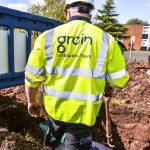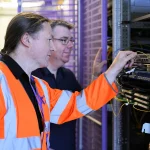Voneus CEO on the “unrealistic” 2025 UK Gigabit Broadband Target

The Founder and CEO of broadband ISP Voneus, Steve Leighton, has told ISPreview.co.uk in a new interview that the 2025 target for every UK home to gain access to gigabit-capable broadband is “unrealistic” and that Ofcom’s approach to regulation needs to take more account of alternative networks (AltNets).
As a business Voneus has actually been around for a good 8 years or so, although they initially spent most of that time on developing products and services for the Voice-over-Internet-Protocol (VoIP) market. By comparison they’ve only really been active in the broadband connectivity sector for 3-4 years.
On the broadband side the ISP has been primarily focused on developing Fixed Wireless Access (FWA) networks for poorly serve villages and towns across various different parts of England (mostly rural areas), with a little bit in Wales. Customers of these services typically pay from about £34.99 per month for an unlimited 30-50Mbps capable superfast broadband service, which comes with a free router and installation.
Advertisement
So far most of that has been powered by a 2017 funding injection of £2.4 million from BOOST&Co and, more recently, they’ve also secured an initial commitment of £10m from Macquarie Capital, which includes the potential to invest up to £30m in phases (here). As part of that Voneus are looking to grow their FWA coverage and to expand into doing more Fibre-to-the-Premises (FTTP) deployments (they have started some in Devon, Bedfordshire, Somerset and Buckinghamshire).
Suffice to say that we were keen to know where the ISP stood on some of the major developments currently taking place, such as the Government’s £5bn aspiration to bring “gigabit-capable” broadband to every UK home by the end of 2025 (here and here). Steve Leighton, CEO of Voneus, thinks this target is “unrealistic” and he also wants to see the current business rates holiday on new fibre (due to end in 2022) being extended so that ISPs can properly plan their investments for the future.
On top of that Steve notes that competition for skilled engineers is starting to mean that “resources are becoming increasingly scarce in the industry” and extremely good engineers in particular are “now starting to command a premium,” which is something that can impact the cost models that providers make for their deployments. We touch on all of this in more detail below.
The Voneus Interview (Steve Leighton)
Q1. Voneus started out by building hybrid fibre optic and fixed wireless broadband networks in order to serve poorly connected communities, often in rural areas. More recently you’ve begun a number of Fibre-to-the-Premises (FTTP) builds, can you tell us a little more about why you’ve started to harness full fibre and what sort of new challenges it has presented?
Advertisement
ANSWER:
The utopian vision is for a full fibre UK. The Government’s views on this outcome have softened recently, with the emphasis being placed much more on a ‘Gigabit Britain’. This has opened the door for alternative technologies to be used in solving the country’s connectivity problem.
Our strategy is very simple. We will continue to serve the rural areas that are underserved by superfast broadband, doing so initially through our Fixed Wireless Access solution. Significantly, FWA is very quick to deploy. By using this technology we can get a community on-line and connected to a superfast service extremely swiftly.
Then, when that community reaches a certain level of take-up, we will deploy fibre, confident in the knowledge that our investment will accrue revenues from day one. This approach mitigates some of the risk associated with an expensive investment in rural fibre.
Therefore, one of the key challenges with rural FTTP deployment is ensuring that we have effective clustering and available fibre backhaul points to provide the economies needed for a full fibre rollout.
Q2. At present Voneus’ existing network connects around 5,000 UK premises (with more added daily), although you’ve recently secured an additional investment of £30m and have spoken of an aspiration to cover 900,000 premises.
Are you able to tell us a little more about when you expect to hit that 900,000 aspiration, how you intend to invest the extra money in order to achieve that and how many premises from the target might benefit from FTTP rather than wireless services?
ANSWER:
At the time of the Macquarie investment 900,000 homes was quoted as the potential scale of the number of addressable homes in rural, poorly connected communities in the UK, highlighting the troubling extent of the UK’s broadband divide. These are typically defined as homes receiving less than 10Mbps today.
Our aspiration over the next 3-5 years is to grow our customer base significantly, using our investment to grow our FWA networks, as well as building FTTP infrastructure for a large number of our communities across the UK, with a strong focus on homes connected rather than homes passed.
We are not short of opportunities and continue to both discover and receive inbound enquiries from communities across the UK who receive speeds of less than 10Mbps. We are supporting our organic growth with strategic acquisitions designed to bring us customers, skills and communities with the potential for fibre rollout.
We are well on our way with that journey, and I think the next 6-12 months will represent a very exciting time for the company as we continue to realise our double-digit growth plans.
Although our investment will fuel our buy and build strategy, we know the importance of ensuring the business, its people, and our systems scale in the same manner. With this in mind, we have made a number of strategic senior management hires from across the Telco sector to provide further insight and experience.
Q3. We note that Voneus has, on occasion, come close to crossing some of your wireless or fibre network coverage with that of a rival other than Openreach, such as Truespeed or Gigaclear. As a provider, how do you approach the issue or threat of overbuild with a rival and what sort of impact can or does it have on your plans?
ANSWER:
We recognise that the UK broadband market is a competitive marketplace. The presence of alternative networks and the sharp increase of private investment in this space over the last few years demonstrates the existence of the opportunity which much of the industry is trying to take advantage of.
To mitigate the impact of this competition, we use data and established criteria to decide where to implement our buy/build strategy, enabling us to spend our money wisely and achieve the best ROI, especially where we have first mover advantage. We avoid knocking on the doors of our competitors’ customers because our view is that the market is big enough to avoid treading on the toes of others. Why overbuild and compete when there are other, significant areas with little to no connectivity that we can focus on helping instead?
However, as you point out, in some of our legacy sites, there has been some overbuild, which has established a new level of competition. Our approach in these areas is to continue to excel in providing the best possible service to our customers, which in our books encompasses superfast, reliable broadband with excellent customer service. Our local customer engagement model means that our customer base often feels a strong affinity with Voneus, which is hugely helpful moving forward as we look to take them on a journey to FTTP.
Q4. If you could change one rule or element of the current market to help your roll-out, what would it be?
Advertisement
ANSWER:
For rural delivery we’d like to use all the existing UK infrastructure to improve the speed for delivery and also to help reduce cost. As an example of this approach, “Open Fibre” in Italy have shown that by using the power networks infrastructure, FTTP can be deployed rapidly.
Q5. The Government has recently been through a fair few rapid broadband policy changes. At the start of 2019 the plan was still to achieve full fibre coverage of every home by 2033 (viable), then it became 2025 (virtually impossible), before finally being watered down to simply “gigabit-capable broadband” by 2025 (this expanded the technology options beyond just FTTP to add Virgin Media’s DOCSIS 3.1 cable network and possibly also fixed wireless broadband or 5G).
Since then the Prime Minister, Boris Johnson, has announced that he will facilitate the new 2025 target by investing £5bn of public money to help bring Gigabit broadband to those in the hardest to reach (final 20%) of premises. Given all of this, what are your thoughts on the viability of the new 2025 target and do you have any recommendations for how the funding should be spent?
ANSWER:
I’m not alone in thinking the 2025 target is unrealistic, even given the recent change in emphasis. We’d need to increase current rates of build across the board (I.E. all businesses that are currently building networks designed to deliver Gigabit-capable services) by a significant factor to meet that. However, as you say, support schemes exist to help soften the investment risks when delivering this broadband rurally.
However, the current scheme (the rural Gigabit voucher scheme) is due to come to an end in March 2021. This makes no sense in my view – if the vision is for a Gigabit Britain by 2025, the scheme should continue to run until then at the very least.
What is clear is that the initial £5bn has not been completely spent. With this in mind, companies like Voneus should be allowed to continue to build, with some level of support from the Government. Removing that support won’t stop the build, because the demand will always be there, but it might slow down its progress, and contribute to missing the Government’s 2025 deadline.
Flick over to page 2 to continue this interview.
Mark is a professional technology writer, IT consultant and computer engineer from Dorset (England), he also founded ISPreview in 1999 and enjoys analysing the latest telecoms and broadband developments. Find me on X (Twitter), Mastodon, Facebook, BlueSky, Threads.net and Linkedin.
« Cardiff Gets £500,000 Full Fibre Boost from Welsh Government
The High Cost of Broadband for USO Excluded UK Communities »






















































Really interesting interview, thanks for posting. I would personally disagree with Steve’s view that 5G / wireless is a suitable alternative to direct lines to each home. I feel like it could be a similar situation to FTTC, which at the time may be enough for the needs of it’s time but will be found outdated eventually and need complete rework. If the likes of WFH, online meetings etc. become more permanent for many, there may be a risk that ping and consistency could become the new bottleneck and wireless may eventually be too unstable to keep the consistent ping needed. Hopefully not to incite any political arguments but I do feel that there should be a government incentive to provide a utility line or duct to each home that multiple ISPs can choose to make use of to at least provide some sort of direct line service.
Also interesting to hear about the need for more skilled engineers, it’s actually a career change that I consider making every so often. I’m curious if there are plans for the likes of Openreach to begin recruiting trainee engineers again sometime soon, although given the current pandemic it makes sense that they aren’t quite at the moment.
Personally, I have no interest in a 5G signal as a replacement for a fixed line. The consistency provided by wireless access isn’t enough for my requirements. But hardly anyone I know connects their home network up via Ethernet. It’s all laptops connected to WiFi. With the rise of unlimited data packages some don’t even bother switching their phones to WiFi at home.
For the vast majority of the people, they don’t really care as long as it’s “fast enough”. 50-100Mbps download is more than enough, all that matters is if they can get a good signal. If they can, fixed line access can be replaced with 4G/5G for many people, until there’s a compelling reason for everyone to need a reliable 1Gbps of bandwidth. Such a requirement is hard to see coming any time soon.
If you need reliability for gaming, online meetings, or just general WFH then fixed line makes sense. For the average person who wants to do internet browsing and watch some Netflix, I can see a case where a large portion of the population won’t pay for fixed line, which makes rollouts uneconomical.
Fixed line (wet bit of twisted aluminium pair) can be far less reliable than a Fixed Wireless Access service!
Many in rural areas only get a few Mbps on their land line. Service is very unreliable when speeds are low as there is no margin for noise. So the service will drop out, often daily and more at peak times.
FWA, 4G, 5G, Docsis, full-fibre all have their part to play as not one solution can fix the UK’s Internet issues quick enough.
FTTH is the end goal but it will not be viable everywhere… Some places are still off-grid for mains power and many more don’t have mains drainage.
Wireless is grate until to many sign up for it, there is only so much bandwidth available, where as with a hard-line connection its more or less dedicated connection
less so if its virgin cable docsis but the 3.1 docsis spec will be fixing that eventually (as it have a lot of bandwidth available)
FTTP to every house is probably going to take until around 2030-31 (you can thank Margaret Thatcher for that in 1992 for blocking bt from investing in there own network, they was going to rip out copper and install fttp to every property)
Maybe someone can comment on the growing need for multiple services into a single prem. Home Working, and remote offices drive different needs than residential services, especially around security, reliability, multi site networking and financials. I see a perfectly acceptable competitive overbuild
Model where two services from different suppliers would be required to serve these needs at one location. Today this isn’t really viable with only a single copper pair per household. And given potential ‘benefit in kind’ issues arising from it may mean these need to be kept separate (expenses allocation). Should make for interesting business development opportunities.